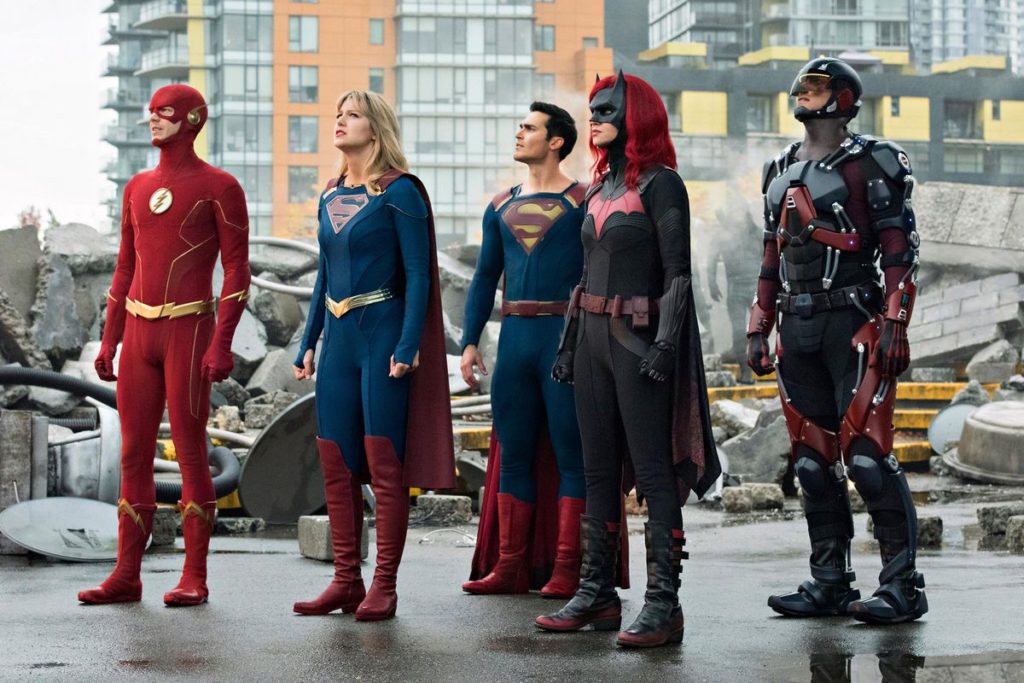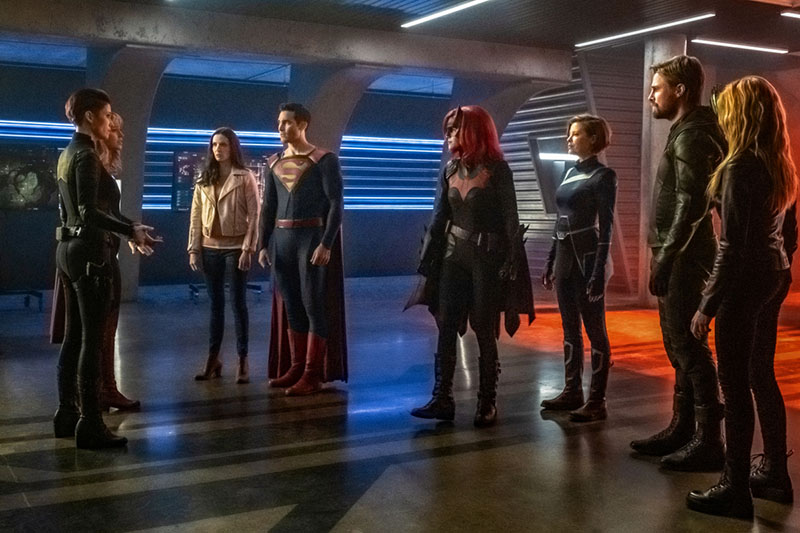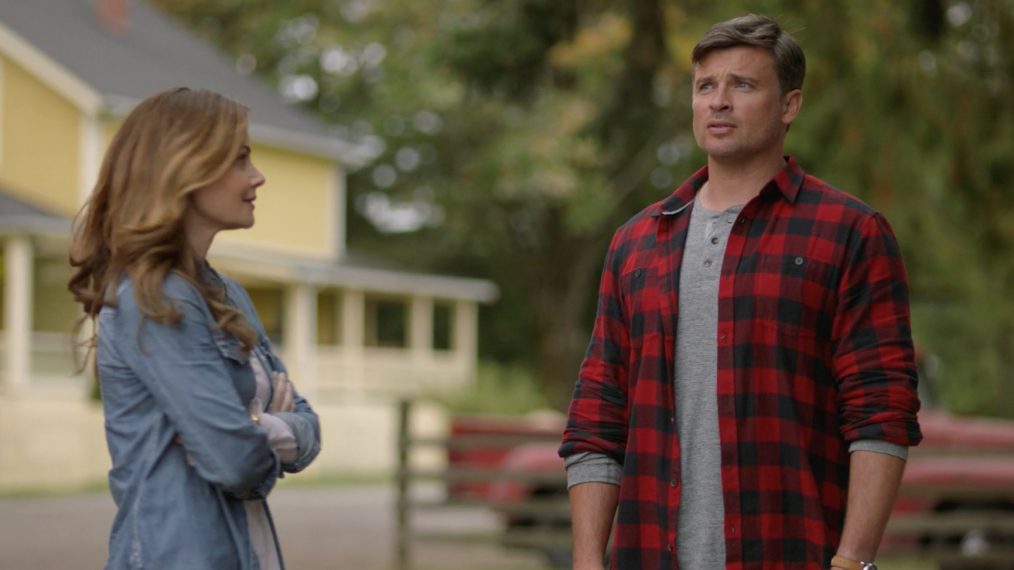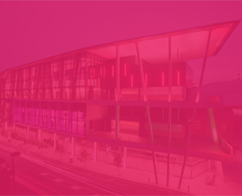
WARNING: Spoilers ahead
When Oliver Queen (Stephen Amell) first suited up as the Emerald Archer in the pilot episode of Arrow, nobody could have predicted the chain of events that would follow.
From the transformation of Barry Allen (Grant Gustin) into The Flash, and the rise of Kara Zor-El (Melissa Benoist) as Supergirl, to the multiple revivals of Sara Lance (Caity Lotz) as the captain of a time ship, the universe first established in Arrow has far separated from the grounded, Nolan-like television series introduced in 2012.
The culmination of eight years of superhero television, DC’s Crisis on Infinite Earths leans into the comic book nature of the crossover event. Inspired by Marv Wolfman’s 12-issue series of the same name, Crisis aims to unite the heroes of the Arrowverse while combining 80 years of DC history into this Endgame-level event.
The purpose of the comic series was to bring together all the properties acquired by DC Comics into one streamlined continuity. Wolfman’s miniseries is renowned for the high death count, the destruction of countless universes, and the combination of five remaining Earths into a singular entity. The two major deaths from the comic series are that of The Flash and Supergirl, who both died at the hands of the Anti-Monitor to save the multiverse from annihilation.
First teased during The Flash‘s pilot, Crisis on Infinite Earths was utilised as the framework for the Elseworlds crossover in 2018, where the Monitor (LaMonica Garrett) tested the heroes of Earth 1 and 38 to prepare them for the graver threat. During this trial, Oliver learns that Barry and Kara are destined to die and offers his own life in place of theirs. During Arrow’s eighth season, Oliver witnesses the catastrophic collapse of the universe containing Earth 2, which prompts a series of trials preparing Laurel Lance (Katie Cassidy), John Diggle (David Ramsey), and Lyla Michaels (Audrey Marie Anderson) for the impending Crisis. The Monitor’s champions are brought to Earth 38 to take a stand against the Anti-Monitor but fall short as Supergirl’s universe is destroyed.
Here, the heroes learn about paragons, which are seven individuals across space and time that are essential in the salvation of the multiverse. After scouring the multiverse for paragons, the seven are revealed to be Supergirl, Earth 96’s Superman (Brandon Routh), Batwoman (Ruby Rose), The Flash, Martian Manhunter (David Harewood), Sara Lance, and Ryan Choi (Osric Chau). After successfully destroying the multiverse, the paragons are stranded at the beginning of time with Oliver Queen reborn as the Spectre, who inevitably dies to restore the multiverse vastly different to its predecessor.

With six DC television programs across its network, The CW traditionally has separated their properties across different universes. A major consequence to the Arrowverse as a result of Crisis is that Arrow, Flash, Supergirl, DC’s Legends of Tomorrow, Black Lightning, and Batwoman exist in the same universe. The new Earth, dubbed “Earth Prime”, will allow more creative freedom, interactions, and narratives across each show.
But what other changes does the multiverse face as a result of Crisis? What does it mean for the Arrowverse if the Green Arrow has died? And what does the merging of three universes mean for the canon of these shows, and the future of these programs?
THE MULTIVERSE
Throughout Crisis on Infinite Earths‘ five episodes, the audience is provided with snippets of what is canon to the Arrowverse’s multiverse. The major consequence is the merger of Earths 1, 38, and 73 into Earth Prime. Marc Guggenheim, executive producer of the crossover event, stated in an interview with Entertainment Weekly that, “We knew from last year, quite frankly, that we were going to merge and create Earth-CW.”
Naming it “Earth CW” could infer that other prominent universes within the Arrowverse have merged to, specifically Earth 2, Earth 3, and Earth X. While no evidence of these universes exists, the presence of Laurel Lance in the future of the Arrowverse suggests that Earth Prime may incorporate other aspects of these universes.
Television programs and cinema throughout the DC archives were incorporated using the multiverse in Crisis. Post-Crisis, Earth 2 is home to the Stargirl series, which will debut in 2020. On this Earth, the Justice Society exists, and focuses on Courtney Whitmore (Brec Bassinger) as she follows in the footsteps of her step-father to become a hero. The tone of this Earth is significantly different to the Earth 2 Pre-Crisis, which featured parallel versions of the heroes on Earth 1.

Photo by Katie Yu/The CW
Also, on the DC streaming service, Earth 9 features the universe containing Titans, and Earth 21 features the characters from Doom Patrol. Interestingly, the two series are set in separate universes, despite having direct ties between them.
The Green Lantern Corps exist on Earth 12, which is monumental in the Arrowverse as it has been long rumoured that the Emerald Knight would appear within the show. The clips showcasing Earth 12 are from the 2008 film Green Lantern which represent the HBO Max Green Lantern television series that is expected to debut in late 2020.
The short-lived Swamp Thing television program makes a cameo on Earth 19. Pre-Crisis, Earth 19 was a relatively prominent universe, as the Collectors Agency, Gypsy (Jessica Camacho), Breacher (Danny Trejo), and the late H.R Wells (Tom Cavanagh) originated in this universe. Whether Swamp Thing also exists on this universe, or the previous universe has been replaced is unknown.
Going further into the DC catalogue is Earth 66, Earth 76, and Earth 90 which are the universes containing the Batman 1966 series, Wonder Woman 1975 series, and The Flash 1990 series respectively. Dick Grayson (Burt Ward) watched his universe consumed by anti-matter, and Barry Allen (John Wesley-Shipp) sacrificed his life for the multiverse in Earth 1 Barry’s place. Unfortunately, Linda Carter did not don her Wonder Woman armour, and instead was featured in the tie-in comic. It is unclear on whether Earth 90 continues to exist, as his world and an expanded roster of heroes were destroyed in the Elseworlds crossover, but this universe was noteworthy as it ties up plotlines still evident from the series.
Earth 89 and Earth 96 feature two of the most adored franchises in history, bringing Michael Keaton’s Batman films and Christopher Reeves’ Superman films into continuity. While Earth 89 was a minor cameo featuring the infamous score by Danny Elfman, a major draw to the Crisis event was Routh revisiting the role of Superman from the Reeves canon. This Superman played a major part in the plot, as the Paragon of Truth, but was replaced by Lex Luthor (Jon Cryer) who schemed against the Man of Steel. In the epilogue, it appears that the Man of Steel received his happy ending, as the Kingdom Come crest had been replaced by the traditional Superman costume.

Photo by Jordon Nuttall/The CW
While Earth 99 does not specifically take place on any DC property, it features a broken Bruce Wayne (Kevin Conroy) who is inspired by the Kingdom Come storyline. In this universe, Wayne succumbs to the darkness and murders villains and heroes to rid the world of threats. The significance of this universe is the utilisation of Kevin Conroy, who is recognised by fans as the definitive voice of Batman, having voiced him in countless DC properties.
 Nine years after its finale, Tom Welling and Erica Durance reprised their roles as Clark Kent and Lois Lane from the decade-spanning series Smallville on Earth 167. His cameo showed that Clark had given up his powers after inspiring a generation of heroes so that he could have a family with Lois, which is a fitting end to the series.
Nine years after its finale, Tom Welling and Erica Durance reprised their roles as Clark Kent and Lois Lane from the decade-spanning series Smallville on Earth 167. His cameo showed that Clark had given up his powers after inspiring a generation of heroes so that he could have a family with Lois, which is a fitting end to the series.
From the same era, Earth 203 features the heroes from the short-lived Birds of Prey television program. The sequence featured Huntress (Ashley Scott) as she watched Oracle’s clock tower being destroyed by the anti-matter wave.
In a surprise cameo that few predicted, the heroes travelled to Earth 666 to make a deal with the devil. Lucifer Morningstar (Tom Ellis) from Lucifer made a guest appearance which was essential to reviving Oliver as the Spectre. A major aspect about this cameo is that it was set before the Netflix series, which means that the series has been set in a Post-Crisis world.
 The most jaw-dropping cameo arrived in the fourth hour, which features Grant’s Barry Allen running into Ezra Miller’s Flash within the speed force. While no universe was allocated to the DC Extended Universe, it confirms that the cinematic slate is canon with the Arrowverse. This is monumental for the Arrowverse, as the shows have been long restricted by the DCEU, and allowing the two universes to coexist in the multiverse enables greater control over DC history on the CW.
The most jaw-dropping cameo arrived in the fourth hour, which features Grant’s Barry Allen running into Ezra Miller’s Flash within the speed force. While no universe was allocated to the DC Extended Universe, it confirms that the cinematic slate is canon with the Arrowverse. This is monumental for the Arrowverse, as the shows have been long restricted by the DCEU, and allowing the two universes to coexist in the multiverse enables greater control over DC history on the CW.
Earths 16, 18, and 74 do not feature any cameos from the DC archives, but instead alternative resolutions to major plots in the Arrowverse. Specifically, consequences where the Legends do not exist, where Oliver Queen lived devastated after Sara’s death on the Queen’s Gambit, where Jonah Hex (Johnathon Schaech) never joined their ranks, and where the team retired after Leonard Snart’s (Wentworth Miller) death respectively.
IS THERE AN ARROWVERSE WITHOUT OLIVER? HOW DOES CRISIS AFFECT THE PAST AND FUTURE OF EARTH PRIME?
Oliver’s sacrifice paved the way for a new era of the Arrowverse but has raised some questions that must be addressed in the near future. The major consequence of Crisis is what is still regarded as canon. While seemingly remaining unchanged, the impact of having access to other heroes during climactic events such as Myriad in Supergirl’s first season, or how Zoom existed if his universe never existed. Each show now has the onus of clarifying continuity for Earth Prime, but the extent of how it will occur is unknown.

Another complication that the characters face is that the heroes are the only ones who realise that history has been rewritten. Nobody remembers the Crisis itself, nor what the world was like before Earth Prime was formed. This could potentially be a powerful plot narrative with non-superhero cast, akin to the decimated Avengers dealing with life post-snap.
Crisis also sets up the future of the Arrowverse in three specific manners. The first is by adjusting the future, which will carry onto Arrow’s final spin-off, Green Arrow and the Canaries. The show follows Mia Queen (Kat McNamara), Laurel Lance and Dinah Drake (Juliana Harkavy) as they deal with the challenges of a revised Star City 2040 following Oliver’s death.
Superman and Lois, debuting 2020, will follow Superman (Tyler Hoechlin) and Lois Lane (Elizabeth Tulloch) juggling their dual identities as superhero and parents to their two sons. Pre-Crisis, DC’s most iconic couple had only one child, but this has changed as a result of the new canon. Throughout comic continuity, Jon Kent has been Clark’s only son, so the addition of a second will mould the mythology further.

The third setup is the formation of a superhero team consisting of The Flash, White Canary, Batwoman, Supergirl, Superman, Martian Manhunter, and Black Lightning (Cress Williams). While never directly calling themselves the Justice League, this is the Arrowverse’s version of the iconic DC team. Having the team established will allow for more mini-crossovers between the shows and allow for a more accessible location for heroes during future crossovers.
Oliver’s death was the devastating catalyst for the crossover. Despite being forewarned in Arrow’s seventh season, watching the man who started this universe die was emotional for both the audience and the characters. One of the best scenes in the crossover is between Sara Lance and Barry Allen; two characters who usually do not share any screen time, bonding over the loss of their ally. Oliver Queen has impacted every character throughout this universe, and his death will continue to be felt in the future of the shows akin to Tony Stark’s in Endgame.
WHAT DOES THIS EVENT MEAN FOR THE FUTURE OF TELEVISION?
While an epic representation of what can be done on superhero television, Crisis on Infinite Earths has far exceeded the limitations established in television history. Previously, when a program concludes its run, it is generally tied up. It is commonplace for some television series’ to be revived or rebooted for another season or a special, but for the most part, once a show ends, it is over.
Crisis on Infinite Earths has taken elements from countless DC properties and made them relevant once more in a separate setting. Fans of the Arrowverse have now been exposed to countless DC properties from the past, which will inspire them to return to these classic instalments. By reviving characters, narrative, and the diegesis from these properties, Crisis on Infinite Earths has transcended what a series finale represents.
The precedent for the possibility of television shows to return further down the line to incorporate into a larger world. This raises the question of whether this is a positive or a negative, as it means that no television series is ever complete as the limitations far exceed their own network.

DC’s Crisis on Infinite Earths set out to create the most ambiguous television crossover in superhero history. Paying homage to the original comic series, the correlation of six current-continuity programs, and the inclusion of countless franchises from DC history allowed The CW to do justice by their characters, while creating a comic event akin to Avengers: Endgame.
The stakes have been raised, setting the foundations for the future of the Arrowverse. As stated in the comic that inspired the event, “Worlds lived, worlds died, and the universe will never be the same.”









